Читать книгу Neurology - Charles H. Clarke - Страница 177
Movement Disorders
ОглавлениеThese can be divided into akinetic‐rigid syndromes, where poverty of movement predominates, and dyskinesias in which excessive movement is the principal feature. Akinetic‐rigid syndromes include idiopathic Parkinson’s, Parkinson‐plus, drug‐induced & post‐encephalitic parkinsonism, manganism (v.rare), childhood akinetic‐rigid syndromes and Wilson’s disease.
Dyskinesias include tremors, chorea, hemiballismus, myoclonus, tics, dystonias, paroxysmal and drug‐induced dyskinesias. The distinction between the two groups is artificial. For example, Parkinson’s can be primarily tremulous; Wilson’s disease can have features of akinesia with an unusual tremor.
No amount of writing surpasses seeing a movement disorder, either in the flesh or on video. See: Chapter 7.
Diagnostic difficulties occur. First, when akinetic‐rigidity becomes apparent, early idiopathic Parkinson’s disease tends to be over‐diagnosed. The reality, evident some years later, is another akinetic‐rigid syndrome. Parkinson’s is almost always asymmetrical, and also should be diagnosed with caution if rest tremor is not apparent. Progressive supranuclear palsy (PSP) or multiple system atrophy (MSA) tend to be symmetrical from the onset. Consider Wilson’s disease in akinetic‐rigidity, or dyskinesia below 40.
Benign essential tremor (BET), though common, can cause difficulty. Usually, tremor occurs when the limbs adopt a particular posture. However, forms of BET mimic benign tremulous Parkinson’s disease, and even cerebellar action tremor.
Early chorea is easy to miss – mistaken for fidgeting. Minor dystonia can also escape recognition. Non‐organic movement disorders are difficult; many labelled initially as functional have organic disease.
